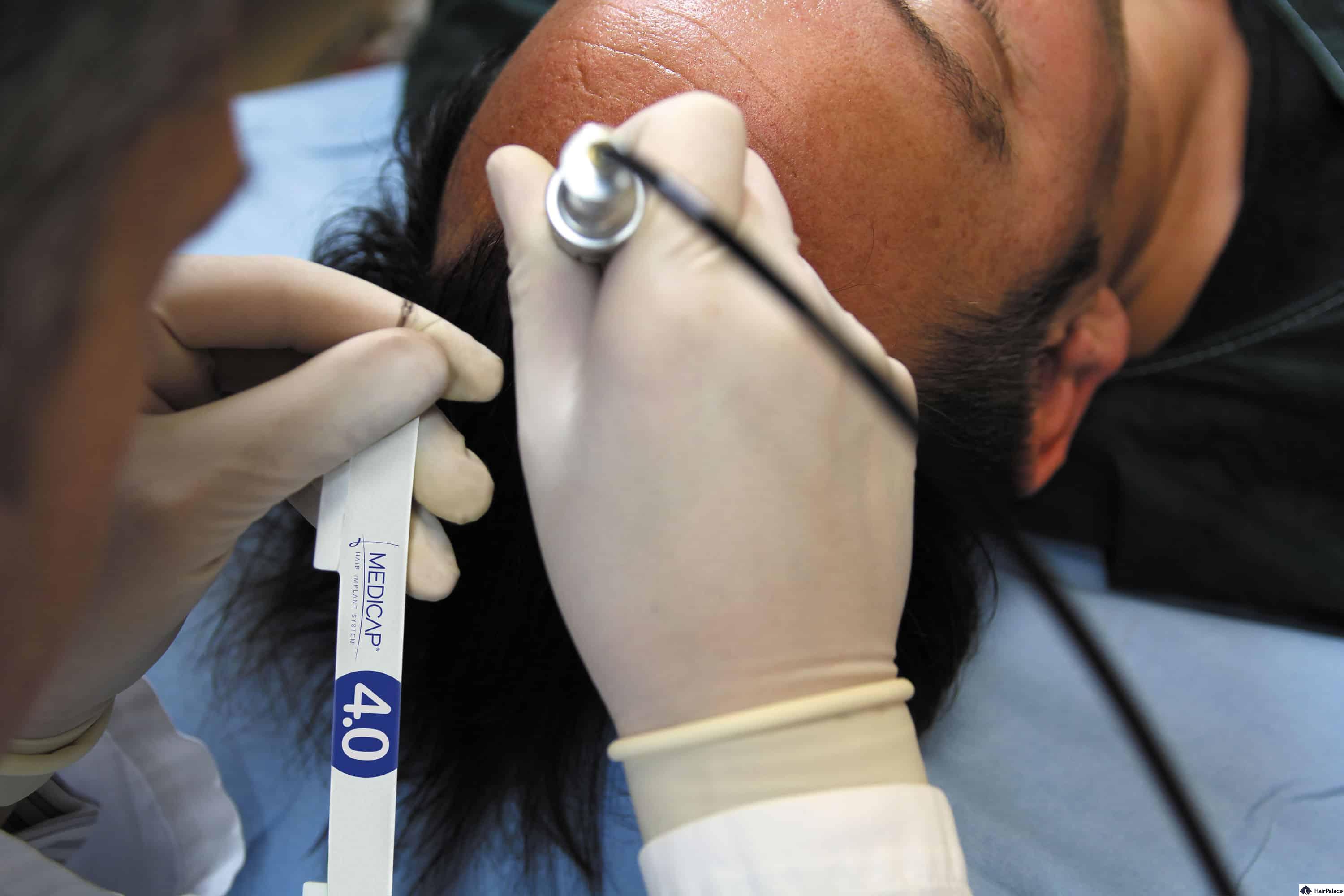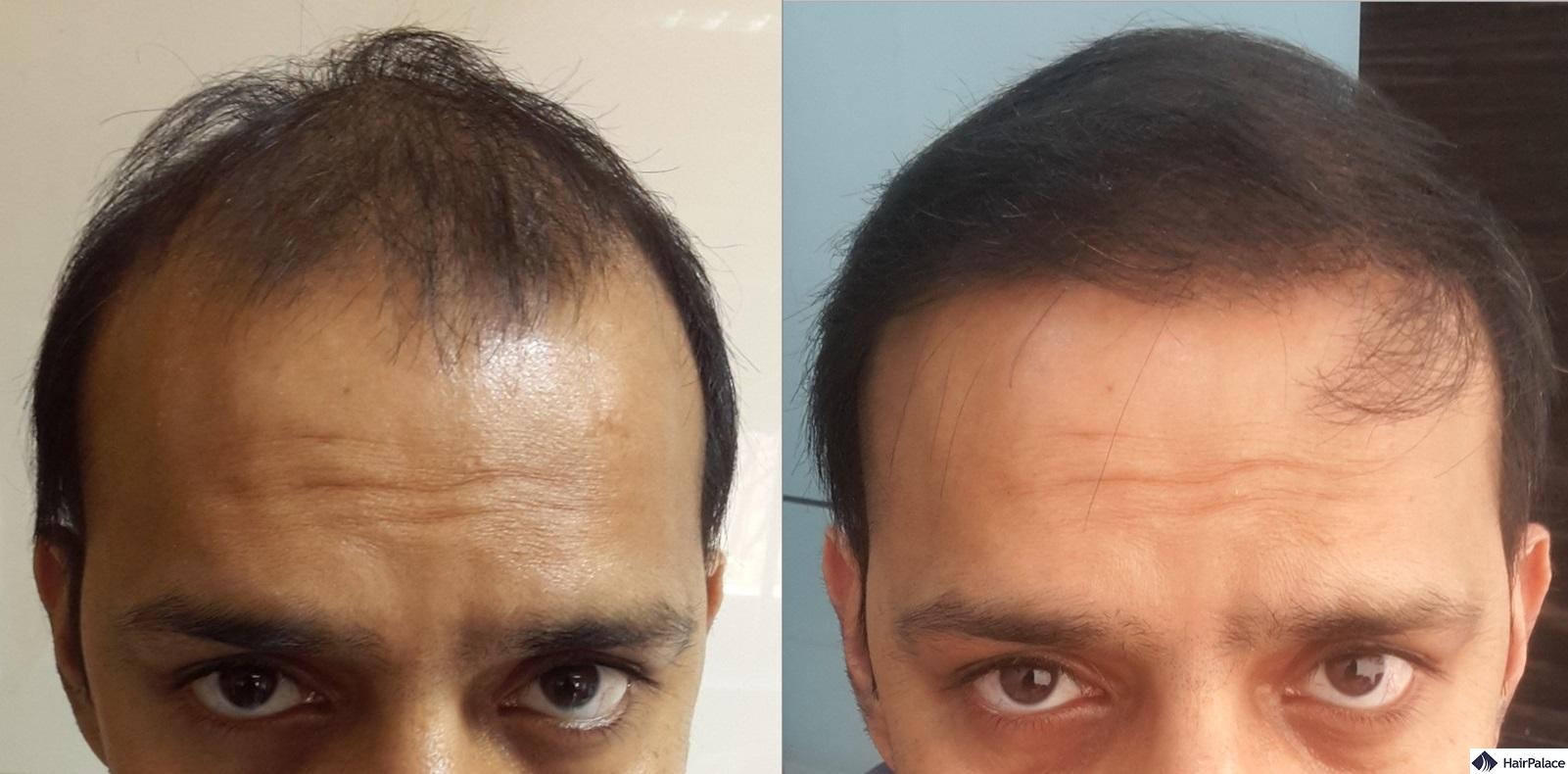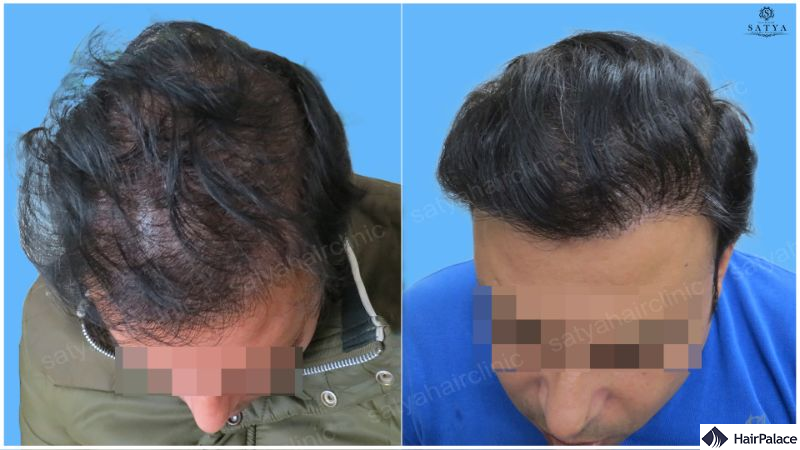Synthetic Hair Transplant: Complete Guide in 2025

A synthetic hair transplant involves the implantation of artificial hair fibres into the scalp to provide the appearance of natural hair.
This procedure is typically used for individuals who are not suitable candidates for traditional hair transplants due to insufficient donor hair.
Synthetic hair transplants offer immediate results, but they require ongoing maintenance and can pose risks such as infection, allergic reactions, and rejection of the synthetic fibres.
But are they worth considering?
Join us as we explore synthetic hair implants and explain the risks and potential benefits.
We’ll go through the basics of the procedure, reveal costs, and risks and show how they measure up against natural hair transplants in terms of results and longevity.
- What is a synthetic hair transplant?
- Synthetic hair transplant cost
- How is artificial hair restoration surgery done?
- Are you a good candidate for an artificial hair transplant?
- Real hair transplant vs Artificial hair transplant
- Synthetic hair transplant before and after
- Synthetic hair transplant side effects and safety
- Should you get a synthetic hair transplant?
What is a synthetic hair transplant?
A synthetic hair transplant is a cosmetic procedure where artificial hair fibres are implanted into the scalp to simulate the appearance of natural hair growth.
The hair fibres are made of grade 6 medical polymer, and they mimic real hair while presenting a very low-risk factor in terms of infection and other complications.
These hairs can be of any colour and resemble all hair types while appearing as natural as possible.
Unlike traditional hair transplant techniques that relocate real hair from one part of the scalp to another, this method uses synthetic hair fibres.
This makes artificial hair transplants great for individuals who may not have sufficient donor hair for an FUE or FUT treatment.
Artificial hair transplants were banned in the 80s by the FDA due to unsafe, aggressive, and detrimental practices.
However, Biofibre hair transplants offer a new modern way to carry out artificial hair surgery safely and effectively.
Patients can choose their preferred hair colour and thickness during their initial consultation.
Synthetic hair transplant cost
Using artificial hair fibres for hair transplants is still relatively new, so the cost of artificial hair transplants can vary.
However, you can generally expect to pay £3 or £4 per graft for a bio-fiber hair transplant.
This means that the average hair transplant procedure involving 2500 grafts could cost as much as £10,000 in the UK.
This is significantly more expansive than natural hair transplants, although you may be able to find a clinic offering the treatment for less.
You should keep in mind that you will only know your final price after an evaluation by your clinic.
How is artificial hair restoration surgery done?
The process is similar to a normal hair transplant, except the fibres are implanted much deeper into the scalp.
The process involves implanting the synthetic fibres into the scalp under local anaesthesia.
These fibres are designed to mimic the look and texture of natural hair.
One of the main advantages of this procedure is that it can provide immediate results.
Plus there is no extraction phase, so the surgery is often significantly faster than standard FUE.
We can usually implant 600 grafts each hour with a traditional FUE hair transplant.
A synthetic hair transplant does at the same speed, the only difference is that there is no need to extract any hairs.

Synthetic hairs are also implanted much deeper into the scalp as no hair root exists.
This means the hair has to be firmly embedded into the skin.
The part of the hair that is under the skin looks like a tiny knot with a hook to help it embed and remain resistant to outside forces.
While the results are immediate, they aren’t permanent. Synthetic hairs are usually able to stay intact for multiple years.
However, you will lose some hair due to brushing and environmental factors so regular top-up treatments are needed to maintain your appearance.
Are you a good candidate for an artificial hair transplant?
Those who lack sufficient donor hair for natural hair transplants, or suffer from extensive baldness are typically great candidates.
It’s also the perfect treatment for those who don’t have the time to wait 12 to 15 months and would rather have immediate results.
However, candidates need to be willing to put in the work in terms of maintenance and aftercare.
Synthetic hair transplantation requires constant upkeep and attention.
Lastly, scalp infections, or a a history of skin diseases that may impact your scalp can significantly reduce the success rate of the surgery.
Therefore it’s essential to have a clean and healthy scalp.
You should consult with a healthcare professional to find out whether artificial hair implants are the right choice for you.
Real hair transplant vs Artificial hair transplant
Artificial hair transplants and real hair transplants offer solutions to hair loss but differ significantly in their approach, outcomes, and considerations.
Real Hair Transplants
Involve transferring hair follicles from one part of the scalp to the thinning or balding areas.
Techniques include Follicular Unit Transplantation (FUT) and Follicular Unit Extraction (FUE) as well as Direct Hair Implantation (DHI).
These natural hair transplant techniques use the patient’s hair, so the results look and feel natural.
Unlike an artificial hair transplant, the results also last a lifetime, and most people only need a single surgery to resolve their hair loss.
Since the transplant uses the patient’s natural hair, the results look natural and can last a lifetime.
The transplanted hair grows, can be cut, and styled, and will generally behave as the rest of the patient’s hair.
Initial hair fall of transplanted hair is common; actual growth starts a few months after the surgery.
The main risks include scarring (especially with FUT), hair transplant infections, cysts, allergic reactions, and potentially unnatural results.
Although complications are mostly mild, and only a fraction of real hair transplants cause side effects following surgery.
Artificial Hair Transplants
Involves implanting artificial hair fibers into the scalp. The procedure can be done relatively quickly and offers immediate results without waiting for hair to grow.
Provides an instant improvement in hair density.
However, synthetic hair does not grow, and its appearance degrades over time, requiring additional synthetic hairs.
There’s minimal to no downtime required, but the scalp must be carefully maintained to avoid infection or rejection of the fibres.
The main downside compared to natural hair transplants is the higher risk of infection, inflammation, and rejection.
Initial costs might be lower than real hair transplants, but ongoing maintenance, fibres replacement, and potential complications treatment increase long-term expenses.
Artificial hair transplant vs Standard FUE
- Your synthetic hair transplant will appear very similar to a natural surgery both in terms of colour and feel
- You will need to take precautions when styling. You shouldn’t bleach your hair, chemical treatments are generally a no-go.
- Unlike a natural hair transplant, you will need regular top-up treatments to restore the hair lost from wear and tear.
- Artificial hairs won’t grow like natural hair, so you’ll be stuck with the same hairstyle for good.
- Artificial hairs will keep the same colour forever, but your natural hair is prone to becoming grey. This can lead to discrepancies which can only be corrected by implanting new synthetic hairs.
Synthetic hair transplant before and after
Synthetic hair transplant side effects and safety
Synthetic hair transplant, while offering immediate results for those seeking to address hair loss, comes with its own set of potential side effects and safety concerns.
Understanding these is crucial before undergoing the procedure.
Side Effects
The risk of infection is significant due to the implantation of foreign materials into the scalp.
Infections must be promptly treated to avoid more severe health complications.
Plus the body may identify artificial hair implants as foreign objects and reject them, which can cause inflammation around the synthetic hairs.
Some individuals may experience allergic reactions to either the prosthetic hair fibres or the materials used during the implantation.
The artificial hair transplant procedure may lead to scarring on the scalp.
While typically minimal, the scarring can impact the outcome of artificial hair transplants and limit the possibility of future interventions.
As with any procedure that penetrates the skin, there’s a risk of bleeding, although this is usually minor and controlled during the process.
Safety
The safety of synthetic hair transplants can vary significantly depending on the country and the specific products used.
Although Biofibre hair transplants are legal in the UK and generally considered safe, there is little data regarding the procedure’s long-term risks and safety.
Ensuring that the fibres and the procedure meet high safety and quality standards is essential, so always do thorough research.
It’s advised to conduct a tolerance test by getting a few hair fibres implanted first, to see how your body reacts to the foreign material.
It’s also important to have your artificial hair transplant carried out by a skilled professional, who has an excellent track record.
Lastly, it’s vital to follow instructions given to you by your clinic to minimize risks and ensure longevity.
Should you get a synthetic hair transplant?
Artificial hair transplants offer a great alternative for those suffering from a lack of donor hair. Whether it’s due to retrograde alopecia or other genetic reasons.
However, you should remember that there is significantly more risk involved in implanting artificial hair compared to a natural hair transplant.
In our view, having a natural hair transplant is always more beneficial than an artificial one.
In case you aren’t though, an artificial hair transplant provides an excellent option to achieve your desired look even if you lack donor hair.
The procedure is generally safe, and while the results aren’t permanent they can be easily maintained with regular follow-up treatments.
Synthetic Hair Transplant FAQ
You can use hair wax or perms on your artificial hair, but you must take great care in keeping them clean. However you shouldn’t bleach your hair, and it’s best to refrain from undergoing any chemical treatments. Such treatments can harm the synthetic hairs and lead to infection or other complications.
Last medically reviewed on January 2nd, 2025
- Triwongwaranat D, Boonchai W, Subchookul C, Sitthinamsuwan P, Thuangtong R. Synthetic hair reactions and treatment of complications: Case reports. J Cosmet Dermatol. 2020 Oct;19(10):2697-2700. doi: 10.1111/jocd.13318. Epub 2020 Feb 15. PMID: 32060980.https://pubmed.ncbi.nlm.nih.gov/32060980/
- Mysore V. Controversy: Synthetic Hairs and their Role in Hair Restoration? Int J Trichology. 2010 Jan;2(1):42-4. doi: 10.4103/0974-7753.66913. PMID: 21188024; PMCID: PMC3002411.https://www.ncbi.nlm.nih.gov/pmc/articles/PMC3002411/
- ISHRS: 2020 Practice Census Resultshttps://ishrs.org/wp-content/uploads/2020/05/Report-2020-ISHRS-Practice-Census-05-22-20.pdf
- Mang, Werner L, et al. Hair Transplantation.Manual of Aesthetic Surgery 2010: 519-540.https://doi.org/10.1007/978-3-540-78795-2_12







